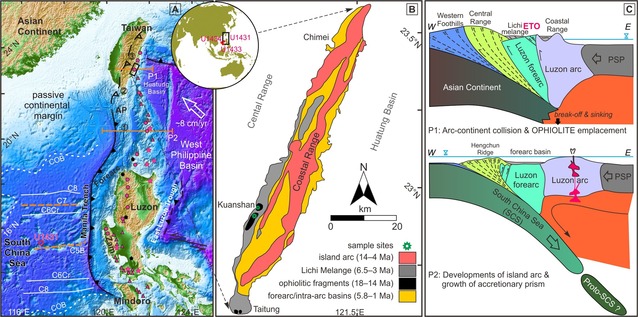Mengming Yu a, b, *, Graciano P. Yumul Jr c, Yildirim Dilek d, Yi Yan b, Chi-Yue Huang a, *
a State Key Laboratory of Marine Geology, Tongji University, Shanghai, 200092, China
b Key Laboratory of Ocean and Marginal Sea Geology, Guangzhou Institute of Geochemistry, Chinese Academy of Sciences, Guangzhou, 510640, China
c Cordillera Exploration Company Incorporated, NAC Tower, Bonifacio Global City, Taguig, Metro Manila 1634, Philippines
d Department of Geology & Environmental Earth Science, Miami University, Ohio, 45056, USA
Abstract: To better understand the establishment of subduction zones, considerable effort is required regarding various factors, such as the time of subduction initiation and the age of the slab’s lithosphere. In this study, adakitic dikes (ca. 17.3 Ma: εNd of 7.4–7.9 and 206Pb/204Pb of 18.27–18.42) were recognized to crystallize along with the normal and enriched mid-ocean ridge basalt (N- and E-MORB)-like oceanic crust (ca. 17.8–14.1 Ma: εNd of 8.8–13.3 and 206Pb/204Pb of 17.71–18.22) in the East Taiwan Ophiolite (ETO). Given that the outcropping in ultramafic sequence, the distinct Nd–Pb isotopes, and the slight precedence than corresponding arc volcanism (≤ ca. 14.1 Ma), the origins of the ETO adakitic dikes are related to amphibolite-facies melting of the subducted slab beneath the Luzon forearc spreading center during subduction initiation. In this respect, we conclude that the sparsely exposed but isotopically heterogeneous E-MORB-type rocks (εNd of 8.8–10.2 and 206Pb/204Pb of 18.06–18.22) are Nb-enriched basalts and relate to the Nb-enriched slab melts derived from further melting of the hot eclogitic residuum of the young South China Sea subducted slab. In addition, the isotopic diversity of N-MORB-like samples can be attributed to the diking of adakitic and Nb-enriched slab melts beneath the Luzon forearc spreading center. Combined with the previously reported early Miocene uplift of the Zambales Ophiolite in the western Luzon, we infer an early Miocene induced-subduction initiation of the South China Sea and the delayed near-trench spreading of the Luzon forearc by <5 Myr. Compared to the absence of Nbenriched slab melts and >20 Myr subducted slab in the genesis of the in-situ Izu-Bonin-Mariana (IBM) forearc and the voluminous Nb-enriched rocks and ca. 0 Myr subducted slab of the Central Palawan– Amnay ophiolites, the sparse Nb-enriched rocks and <15 Myr subducted slab of the ETO sequence invoke the governing factor of slab’s lithosphere age during subduction initiation magmatism. We propose that the lack of Nb-enriched slab melts in the forearc chemostratigraphy of the Oman Ophiolite may indicate the subduction initiation of an old and cold oceanic plate.

Full article:https://doi.org/10.1016/j.epsl.2022.117367
Free download link: https://authors.elsevier.com/a/1eTT3,Ig4RIQa

